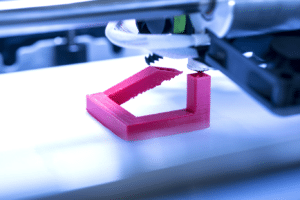
The dawn of 3D printing came with predictions it would bring about the next Industrial Revolution. This process, otherwise known as additive manufacturing, has indeed brought about massive changes, particularly in aerospace.
Nonetheless, few trending stories cover the limits of 3D printing, which are extensive given the technology is still relatively new.
In this blog, find out why 3D printing has worked so well for the aerospace industry—but why these precise qualities make it difficult to adapt to other industries.
To start, there’s no real difference between 3D printing and additive manufacturing. Used interchangeably, these terms refer to processes that create objects by adding materials layer by layer.
(Additive manufacturing could be considered the opposite of processes like precision plastic machining, which create objects by removing materials layer by layer.)
In 3D printing, a digital file dictates to the “printer” the precise design in which to shape the material (usually a durable thermoplastic). The result: stunningly complex designs printed in one piece.
The key is customization.
3D printing is useful for numerous applications in aerospace because this industry leans on highly custom, costly parts that don’t benefit from economies of scale. Unlike toothbrushes or cups, airplanes are made in much smaller batches using designs that may be unique to each individual unit.
The same is true for the medical industry, which has seen amazing advances thanks to 3D printing. Anyone following the news has seen stories about 3D-printed prosthetics, medical models and even organs. These advances have been made possible by a process that can create parts customized to specific anatomic circumstances.
There are a few reasons other industries have been slower to implement 3D printing in their production processes, and why processes such as CNC machining and plastic injection molding have nothing to fear:
Need custom plastic parts? Reading Plastic & Fabrication has been machining the world’s most advanced plastics for decades. We’d love to talk solutions.
Let us share our expertise with you – give us a call at 610-926-3245 to discuss your project. You can also reach us via or by filling out our contact form.